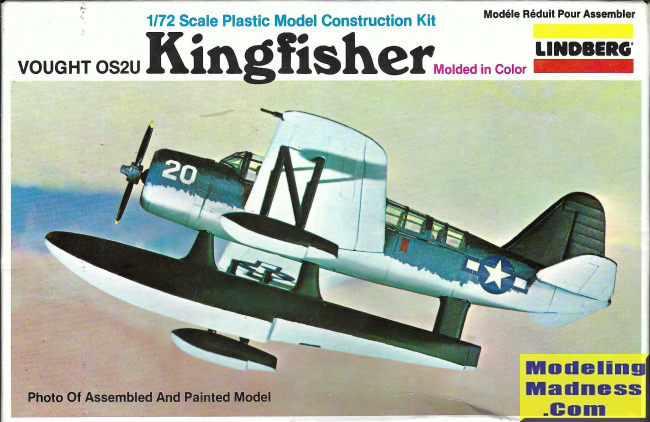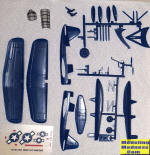
Lindberg 1/72 OS2U Kingfisher
| KIT #: | 940 |
| PRICE: | $ |
| DECALS: | One set of stickers |
| REVIEWER: | Chris Mikesh |
| NOTES: |

| HISTORY |
(Edited from Instruction Seat) Designed for the US Navy as a two-seat observation and scout float seaplane, the Vought Kingfisher was flown for the first time on July 20, 1938 and attained a maximum speed of 177 mph. The US Navy took delivery of the Kingfisher in 1940 and the first ship to be equipped with the new planes was the USS Colorado. Operating from the catapults of the battleship and cruisers, the Kingfishers became known as the workhorse of the US Navy fleet. Among the many roles performed by the Kingfisher were those of naval gunfire spotter, anti-ship patrol, shipping attack and on one occasion served as a dive bomber. The rescue of Captain Eddie Rickenbacker and his crew in the South Pacific was accomplished by a Kingfisher floatplane which taxied across 40 miles of rough sea to bring these men to safety. Kingfisher aircraft were also used as catapult launched aircraft with the British armed merchant cruisers. With floats removed and a split type landing gear bolted to the fuselage, the Kingfisher served as training planes for the British pilots and the West Indies.
| THE KIT |
 …And
now for my next trick, I’m going to pull Silverfish out of a kingfisher! What am
I thinking!? RAID!!! Once I got the bugs out of the box (and other kits), I
discovered a long-remembered kit I used to fly around my bedroom. But really –
this isn’t a bad kit.
…And
now for my next trick, I’m going to pull Silverfish out of a kingfisher! What am
I thinking!? RAID!!! Once I got the bugs out of the box (and other kits), I
discovered a long-remembered kit I used to fly around my bedroom. But really –
this isn’t a bad kit.
Pros: Few parts – that way you can concentrate on paint and decals practice. A great way to try out a new airbrush or technique. Recessed panel lines (Hawk and Lindberg were ahead of their times in the early ‘60s with recessed lines). Simplified interior (see below). Canopy structure is better than Airfix (I’ve built both). Easy option between floats or landing gear.
The unexpected advantage is that the Wings&Elevator are pass-through on the fuselage. So, this is an ideal project to pre-paint (yellow wings and red elevators) before final assembly. Minimal masking needed potentially. See below regarding decals/paint options.
Cons: No cockpit – just an under-sized figure on a seat – so the builder will need to put something together that represents a cockpit. The kit came with no canopy, so I cannibalized one from an old Kingfisher I built when I was 12. The old model (minus Silverfish) is still in the attic. Stick-on markings are not going to work. Many inaccuracies like fuselage width, and propeller size will plague the advanced modeler.
Since this kit is either float or Landing gear, there will be extra holes to fill in before painting. Decide early which version you will use.
| CONCLUSIONS |
This is a very simple entry level model. It was not made for an advanced modeler – therefore give this kit to the Grandsons. So, if you are a builder with AMS (Advanced Modeler Syndrome) take two Tylenol and put the kit back on the shelf in the morning.
Those Stick-On kit markings just won’t do. I purchased the Print-Scale decals (72-122) which provides options for 11 different aircraft. My intention is to do the Landing Gear version with yellow wings and option #11 on the decal sheet. It is very tight, so watch where you are cutting and clipping. The decals themselves look pretty good and Print-Scale has a good reputation.
37 Silverfish were killed in the selection of this kit. The funeral will be held on December 32nd at the Terminix Facility, mixing vat #3. Wear a gas mask. (Will not harm pets.)
Chris Mikesh
October 2022
Copyright ModelingMadness.com. All rights reserved. No
reproduction in part or in whole without express permission.
If you would like your product reviewed fairly and fairly
quickly, please
contact
the editor or see other details in the
Note to
Contributors.